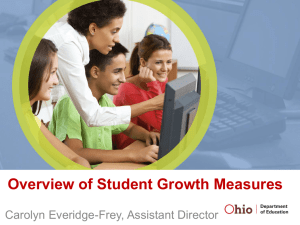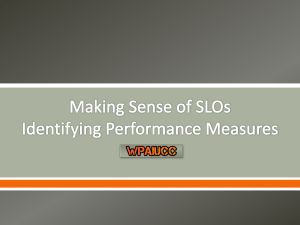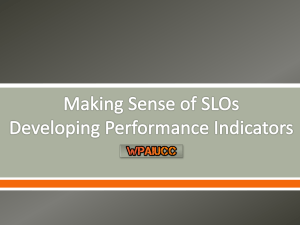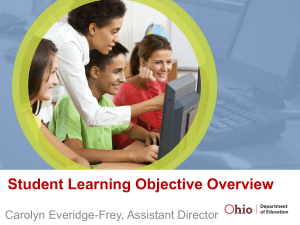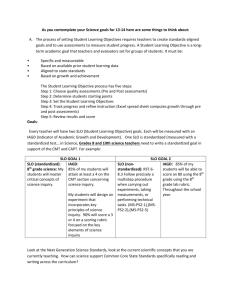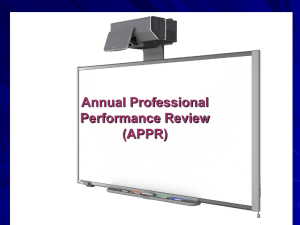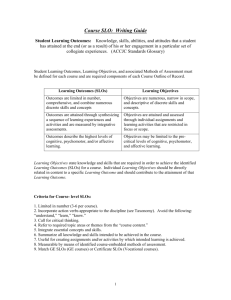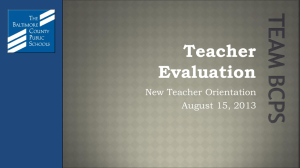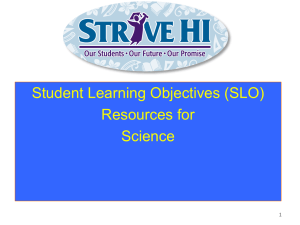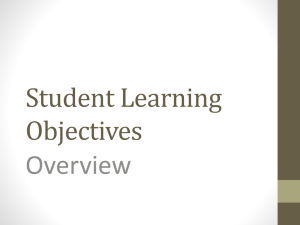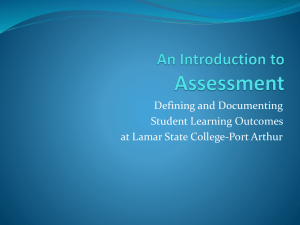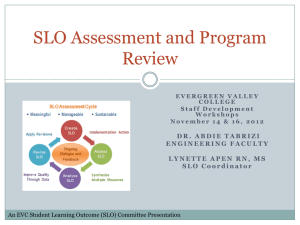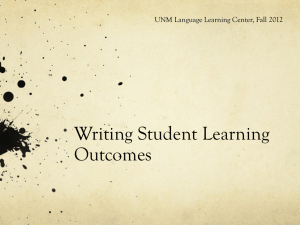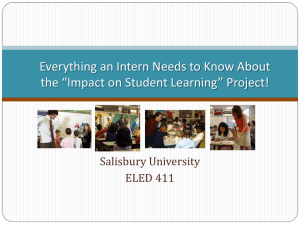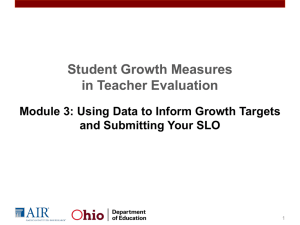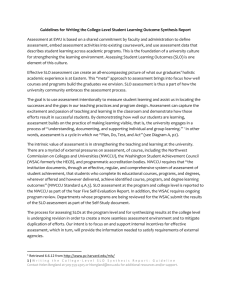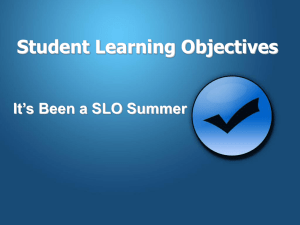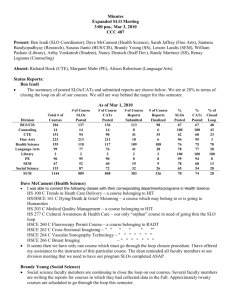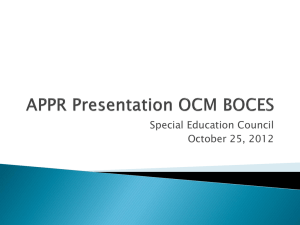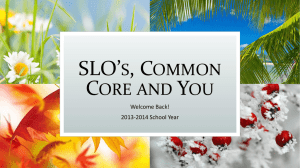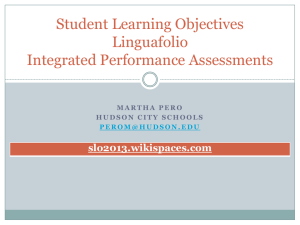January22Presentatio..
advertisement
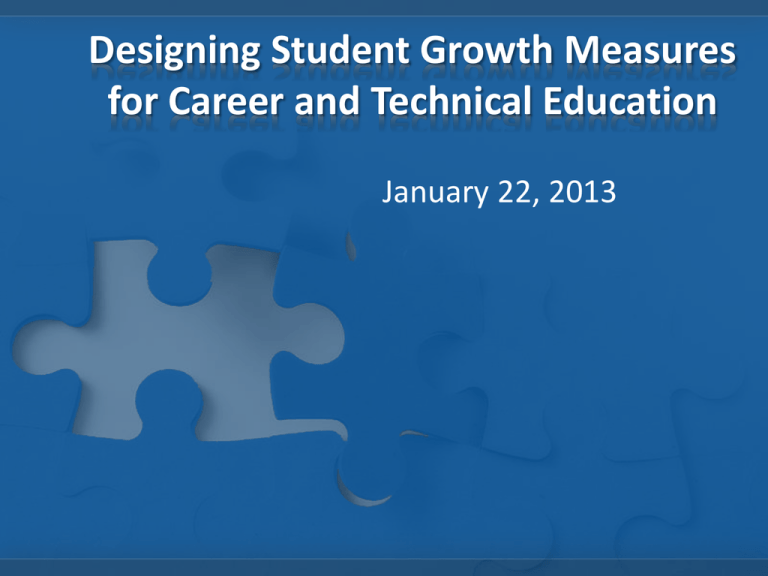
Designing Student Growth Measures for Career and Technical Education January 22, 2013 MIKE MCDANIEL, PRESIDENT OHIO ASSOCIATION OF CAREER-TECHNICAL SUPERINTENDENTS STEVE GRATZ, DIRECTOR CAREER-TECHNICAL EDUCATION OHIO DEPARTMENT OF EDUCATION ROBIN WHITE, CEO/PRESIDENT GREAT OAKS CAREER CAMPUSES Student Growth Measures in CTE Discussion Group Great Oaks Career Campuses • Robin White • Steve Jackson • Jon Quatman • Pam Hunt • Heather Sass • Laura Gale • Andy McCool Warren County Career Center • Maggie Hess • Gary Patton Mid-East Career and Technology Centers • Barbara Funk Delaware Area Career Center • Mary Beth Freeman • Tammy Hall Miami Valley Career Technology Center • Harold Niehaus C-TEC • Joyce Malainy • Mary Kay Andrews • Laura Bowers • Ginny Evans Tolles Career and Technical Center • Kim Davis Meeting Objectives 1. Purpose and framework for SLOs 2. Use of assessment data in SLOs 3. Review of sample SLOs 4. Emerging issues for CTE districts 5. Measures of student growth 6. Experience with variety of assessments 7. Network for SLO development Introductions Ohio Department of Education • Carolyn Everidge-Frey Student Growth Measures Specialists • Chad Rice, SE Region • Mark Robinson, NE Region • Donna Huber, Central Region • Apryl Ealy, NW Region • Katrina Wagoner, SW Region ESC Representatives • Paul Smith, Hamilton County • Meghan Griffith, Southern Ohio • Lou Staffilino, Central Ohio • Cynthia Yoder, Central Ohio Contact information is included in the workshop handout packet. REVIEW OF STUDENT LEARNING OBJECTIVE (SLO) EXAMPLES HEATHER SASS GREAT OAKS CAREER CAMPUSES SLO Template Checklist and Feedback Form 1. Baseline and Trend Data 2. Student Population 3. Interval of Instruction 4. Standards and Content 5. Assessment(s) 6. Growth Target(s) 7. Rationale for Growth Target(s) Student Population • Identifies the class or subgroup of students covered by the SLO • Describes the student population and covers any contextual factors that may impact student growth • If subgroups are excluded, explains why and if they are covered in another SLO Interval of Instruction • Matches the length of the course • Length of class period • How often the class meets Standards and Content • How the SLO will address applicable standards • Represents the big ideas or domains of the content – Technical Knowledge and Skills – Academic Knowledge and Skills – 21st Century Skills • Identifies core knowledge and skills as required by the applicable standards Asssessment(s) • Identifies assessments reviewed by content experts (valid and reliable) • Select measures with sufficient “stretch”—all ability levels • Provides a plan for combining assessments if multiple are used • Follows the guidelines for appropriate assessments Guidelines for Appropriate Assessments • Is the assessment aligned to both my students’ learning objectives and to the appropriate grade- or content-specific standards? • Does the assessment allow high- and lowachieving students to adequately demonstrate their knowledge? Does it have enough “stretch?” • Is the assessment valid and reliable? Rigorous Expectations for Assessments • Recall—Level One • Basic Application of Skill or Concept— Level Two • Strategic Thinking— Level Three • Extended Thinking— Level Four Evidence-Centered Design of Assessment Less Focus On Assessing: • What is easily measured • Discrete, declarative content • Content knowledge • What learners do not know More Focus On Assessing: • What is most highly valued • Rich, authentic knowledge and skills • Understanding and reasoning, within and across content areas • What learners understand and can do Baseline and Trend Data • Identifies sources of information about students • Draws upon trend data, if available • Summarizes the teacher’s analysis of the baseline data by identifying student strengths and weaknesses Growth Targets • All students have a growth target in at least one SLO • Sets developmentally appropriate targets • Creates tiered targets when appropriate • Sets ambitious yet attainable targets Rationale for Growth Targets • Demonstrates teacher knowledge of student content • Explains why target is appropriate for the population • Addresses observed student needs • Uses data to identify student needs • Explains how targets align with broader school and district goals • Sets rigorous expectations for students and teacher(s) Procedures for Review • Review the Health Technologies SLO • Provide feedback on each category of the checklist – Warm: strengths that reflect the criteria – Cool: suggestions for refinement or improvements • Be prepared to share sample warm and cool feedback with the large group DEBRIEFING THE SLO REVIEW HEATHER SASS GREAT OAKS CAREER CAMPUSES Debriefing Questions 1. What are the characteristics of effective CTE SLOs? Would you add or alter any criteria on the checklist? 2. What are the challenges in implementing SLOS for – Districts – Administrators – Teachers STEPS FOR DESIGNING A LOCAL STUDENT GROWTH MEASURES PLAN PAM HUNT GREAT OAKS CAREER CAMPUSES Steps for Designing a Local Student Growth Measures Plan 1. Conduct an inventory of needs and resources 2. Determine and create student growth measures to be used 3. Communicate expectations and refine the entire process Conduct an Inventory of Needs and Resources 1a. Explore opportunities for collaboration with other LEAs, educational service centers (ESCs) and higher education institutions within your community and/or region. 1b. Determine which teachers on staff are required to be evaluated by the new system. Conduct an Inventory of Needs and Resources 1c. Categorize teachers into three groups: – Value-added data – ODE approved data list – None of the above 1d. Determine available assessments and develop a list of assessments and other data that are appropriate for use in combination with SLOs in various grade levels and content areas within your LEA. Great Oaks Inventory of Assessments by Program/Course • Program/Course • Assessment Name • Assessment Details/Purpose Steps for Designing a Local Student Growth Measures Plan 1. Conduct an inventory of needs and resources 2. Determine and create student growth measures to be used 3. Communicate expectations and refine the entire process REGIONAL MEETINGS NETWORKING TO SUPPORT SLO IMPLEMENTATION Discussion Guide • • • • What is currently underway? What assessments are in place? What resources are available? How can we collaborate? Regional Facilitators Northwest Region--Executive • Sharon Mastroianni • Apryl Ealy • Laura Gale Central Region--Judicial • Mary Beth Freeman • Lou Staffilino • Donna Huber Southwest Region • Maggie Hess • Paul Smith • Katrina Wagoner Northeast Region • Jerry Brockway • Mark Robinson • Cyndi Yoder Southeast Region • Pam Hunt • Stan Jennings • Meghan Griffith Regional Report Out • Discussion Highlights • Collaboration and Next Steps

